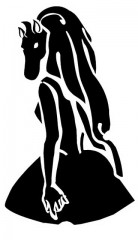The Ghosts of San Juan Chamelco
written by Bob Makransky
Like many towns in Guatemala, San Juan Chamelco, Alta Verapaz, used to have a la llorona, a female spirit who wails in the night. The llorona’s cries often can be heard near a house where someone had just died.
Indeed, since Chamelqueños usually knew which of their neighbors were gravely ill, it was common to remark, “Oh, Fulano de tal must have died!” whenever they heard the llorona’s cries. The children would quake in terror and stuff their ears with cotton when they heard the cries; the more rational adults claimed it was nothing more than a bird calling. An attempt was once made to run the llorona down, but the only thing visible at the spot from which the cries were heard was a dust devil.
Another apparition that Chamelco shares with many other Guatemalan towns is a temptress who lures lustful men to their deaths. In Chamelco she is called Siguanaba, and she is often encountered at night beneath the giant ceiba tree in front of the church or near the bridge of Nani in barrio Chitubtu (the southeast end of town on the road to Concepción).
She appears as a young girl with long, shiny black hair and a beautiful figure, though her face is always veiled in shadow. She carries a bar of soap in a golden bowl in her hands. Some men—the lucky ones—foam at the mouth and faint from fear at the sight of her. But the bolder and lustier men are captivated by her; she flirts with them and invites them to bathe with her beneath the bridge. If they accept, she strangles them to death with her long hair.Once, a long time ago, a widower was courting a woman in Concepción. As he crossed the bridge of Nani one night he thought he saw his beloved approaching. He had a bottle of trago with him, and the apparition invited him to sit down and drink with her. He got drunk and passed out, and when he awoke the next morning he found himself in a patch of brambles on top of a nearby mountain, with no notion of how he’d gotten there.
The apparition appears as a young girl with long, shiny black hair and a beautiful figure, though her face is always veiled in shadow.
Not all of Chamelco’s ghosts are maleficent. In Barrio Santo Domingo (the north end of town) there is a barranca near which a little boy can sometimes be seen around 3 a.m. He is about a foot and a half tall, dresses in rags, and carries a little bag. If you are nice to him—offer him food and help or embrace him—he will give you his bag, which contains a map showing where a great treasure lies buried.
Many of Chamelco’s ghosts are associated with certain mountains or caves. Saktzoxul (white rooster) is a mountain on the road midway between Cobán and Chamelco. At midnight travelers on the road returning home from Cobán often hear a ghost rooster crowing on top of the mountain.
The hill Chank’an (where Chamelco’s school now sits) is said to be alive, and to be very resentful of people. In the old days Chamelqueños had to keep their animals from straying on this hill because to go over there looking for them was to invite all sorts of trouble. The spirit of the hill would frighten people with noises like snarling wild cats by night and with hordes of snakes by day.
The snakes came out of a cave (now blocked up) located beneath the sacrificial rock, near the entrance to the school, on top of which is now built a staircase leading to a lookout point. This rock, which affords a nice view of the church and town, was formerly the site of human sacrifices, and at night screams and groans can still be heard issuing from it. After the conquest, when the church was being built, this rock was the place where disaffected K’ekchis who refused to work on the church were executed.
On the south side of the hill Chank’an lies the hill of Saxa’an, where the apparition of an old woman used to be seen gathering firewood in the distant woods. There is a spring between these two woods (across the street from what is now Chamelco’s kindergarten) where in the old days the neighbors would draw their water. It is said that the ghost woman of Saxa’an used to wash her clothes in this spring at night, since in the mornings it would often appear turbid and foamy.
The cave of Saquic is located in a pasture southeast of town on the right side of the Campat road, 300 meters from where it branches off from the cemetery road. The entrance to this cave is streaked with a red liquid, which leaches out of the rock and which the K’ekchis say is blood. They say that this cave was another site of human and animal sacrifice, and that groans and cries can be heard here at night. The candles that burn before the crucifix in this cave indicate that it is still a place of propitiation.
The incidence of apparitions in Chamelco has radically decreased since the introduction of electricity and street lighting in the late 1940s. Ghost tales are preserved now mostly as the stories which Chamelco fathers and grandfathers use to entertain and frighten the next generation of Chamelqueños.
